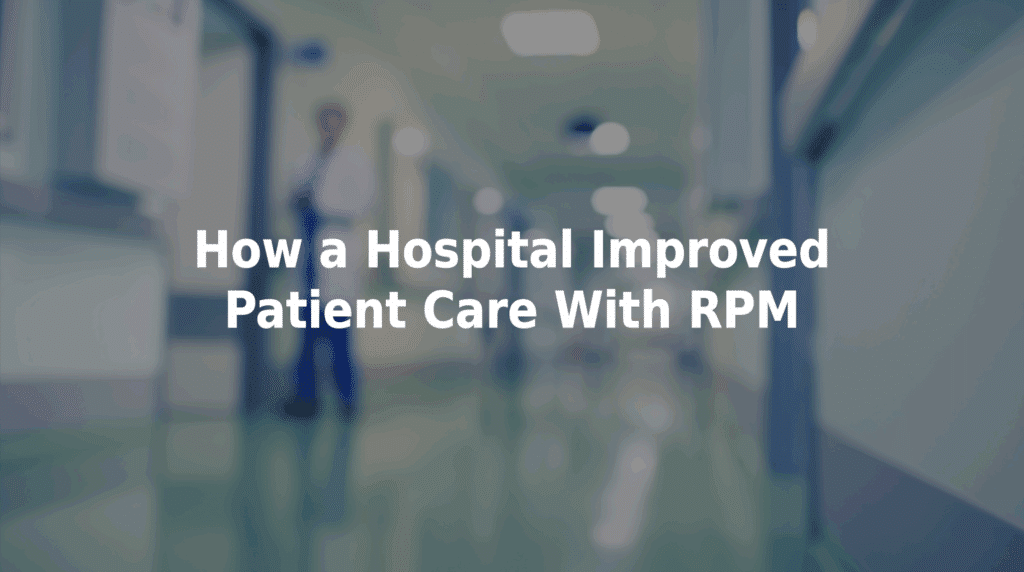How a Hospital Improved Patient Care With RPM
With increasing demands on staff, stricter reimbursement policies, and the transition to value-based care, hospitals are turning to remote patient monitoring (RPM) to extend care beyond discharge. RPM isn’t just about adopting new technology — it’s about transforming workflows, strengthening patient relationships, and achieving measurable clinical impact. Let’s explore how a hospital improved patient care with RPM, reduced readmissions, and helped its staff.
The Challenge: Managing Post-Discharge Risk
A hospital system was seeing too many patients return within 30 days of discharge — especially those with chronic conditions like congestive heart failure (CHF), diabetes, or COPD. Traditional follow-up care wasn’t enough to catch early warning signs, and in-person visits were often too late or too limited in scope.
They needed a solution that would:
- Monitor patients continuously at home.
- Provide clinical oversight between visits.
- Reduce unnecessary emergency department use.
- Improve patient confidence and satisfaction.
The Solution: A Turnkey RPM Platform
The hospital implemented a complete RPM system that addressed all of its needs — without requiring them to invest in additional software or infrastructure. It included:
- HIPAA-compliant monitoring devices (blood pressure cuffs, pulse oximeters, glucose meters).
- 24/7 nurse triage support to review abnormal readings and contact patients directly
- Customized escalation protocols tailored to each patient’s condition.
- Platform integration with the hospital’s EHR for seamless documentation.
- Full patient onboarding and support, which improved engagement and treatment adherence.
The Results: Patient Care Transformed
By implementing an RPM system, the hospital benefited in several key ways, including:
- Improved early detection of health complications, allowing for faster clinical response.
- Reduced 30-day readmissions, particularly among heart failure and COPD patients.
- Greater patient satisfaction, with patients reporting they felt “connected and cared for” even after discharge.
- More efficient care team workflows, with triage nurses managing alerts and reducing unnecessary follow-up visits.
RPM didn’t replace the hospital’s care model — it enhanced it, allowing clinical teams to intervene when needed most.
Lessons From the Process
RPM success doesn’t come from devices alone. It’s the combination of smart technology and clinical expertise that drives results. Here are ways other hospitals can see similar results.
- Start with high-risk populations to make the greatest initial impact.
- Use nurse triage to manage alerts and avoid overwhelming your staff.
- Ensure patients understand the value of monitoring — education is key to adherence.
- Integrate monitoring data into care plans so follow-ups are timely and personalized.
- Track performance metrics to demonstrate value and support program expansion.
TriageLogic’s RPM program includes guidance through each of these steps, offering operational support, technical training, and outcome analysis.
Advice for Other Hospital Administrators
If your hospital is considering RPM, here’s our advice:
- Don’t settle for systems that only provide data — you need clinical interpretation and patient engagement.
- Choose a partner that supports your staff, not one that adds to their workload.
- Be clear on your goals (e.g., reduce readmissions, improve CMS scores) and select a solution that aligns with them.
- Look for scalability and long-term support — RPM is not a one-size-fits-all tool.
Ready to Improve Patient Care With RPM?
If you’re ready to close care gaps, improve outcomes, and build a stronger relationship with your patients, TriageLogic is ready to help! Contact us today to learn more about RPM care that makes a real difference.

